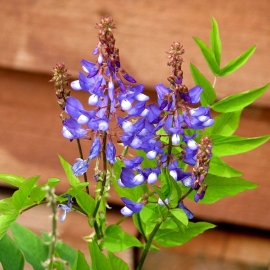






Organic Goat's Rue Seeds (Galega Orientalis)
1.14 €
Galega orientalis, commonly known as Goat's Rue is an ancient ornamental plant that, throughout history has been extensively cultivated as a forage crop, a bee plant, as a green manure, a medicinal herb and as an ornamental.
-
Organic Goat's Rue (Galega Orientalis)
Galega orientalis, commonly known as Goat's Rue is an ancient ornamental plant that, throughout history has been extensively cultivated as a forage crop, a bee plant, as a green manure, a medicinal herb and as an ornamental.
In the garden, this informal plant looks best when scrambling amongst low branches of shrubs, which support the handsome foliage and allow the stems of mini-sweet pea shaped flowers to space themselves out and make a good display. In wild gardens, self-sown seedlings produce a delightful natural effect, erupting in spring to produce countless sprays of fragrant lavender-blue flower spikes.
Galega orientalis is a robust perennial that succeeds in most soils, even in poor soils but will repay generous treatment. The plant prefers full sun and a deep moist soil but will also succeed in light shade. It is very tolerant of neglect and can be grown in quite coarse grass, which can be cut annually in the autumn.
The plant has a smooth and hollowed out erect branching stems and pinnate leaves. It can grow to 150cm (60in) in height and a spread of 90cm (36in). The stems are best supported with twiggy pea sticks to raise them up off the ground, if left unsupported in rich soil they may trail over the ground or form untidy hillocks.
This species blooms in summer through to early autumn with erect racemes 15cm (6in) in length of lavender-blue flowers. In good growing conditions the plants self seed, so deadhead in borders. Congested plants can be divided in spring.
Galega orientalis is a species of flowering plant in the Fabaceae, the legume family. It is known commonly as fodder galega and eastern galega. It is cultivated as a fodder and forage for livestock.
This species is native to the Caucasus. Its native range includes parts of Russia, Armenia, and Azerbaijan. It has been introduced to many other regions for use in agriculture.
The plant can grow on a variety of soil types, performing best on deep, light, friable, well-drained, higher-pH soils. It is quite tolerant of winter cold, but late-season frosts can damage fresh growth. It is somewhat tolerant of drought and flooding. It does not do as well on acidic, peaty, or water-logged soils. It responds well to supplemental phosphorus and potassium.
Like many other legumes, it fixes nitrogen. Its root nodule bacterium is Rhizobium galegae. Growers must ensure that their seed has been inoculated with it to produce adequate plant growth. Some strains of R. galegae are more effective symbionts than others, and different strains compete on one plant. When a less effective strain outcompetes effective strains, the plant does not grow as well.
The rhizome of the plant makes it persistent in the field; the rhizome spreads, sending up new stems, and the plant can live well over ten years, even exceeding 30 years in some areas.
This plant is grown to feed livestock. Its potential value as a fodder was first suggested in 1908, and trials began near Moscow in the 1920s. It is productive, persistent, and nutritious, with high protein. It contains high levels of carotene, minerals, and vitamins, especially vitamin C. It produces many crops of vegetation, its rhizome continuing to produce stems as it grows. It can be cut down repeatedly and taken for hay and silage, and the stubble can be grazed. The whole plant is not generally suitable for grazing, though. It works well as a companion to a non-competitive grass such as timothy or fescue. In cold northern regions it is valuable because it produces vegetation earlier in the spring and continues later in the fall than some other forages. It is low in toxic alkaloid concentration, making it useful as feed when its alkaloid-rich close relative Galega officinalis is not.
The plant has been investigated as a source of biogas, and it has produced a good amount in trials when mixed with grasses and manure.
It has been tested as an agent of bioremediation of oil-polluted soils. Some of the bacteria it hosts can degrade soil pollutants such as toluenes.
It is also grown as an ornamental plant in gardens.
The plant has also been considered a prospective energy crop.
